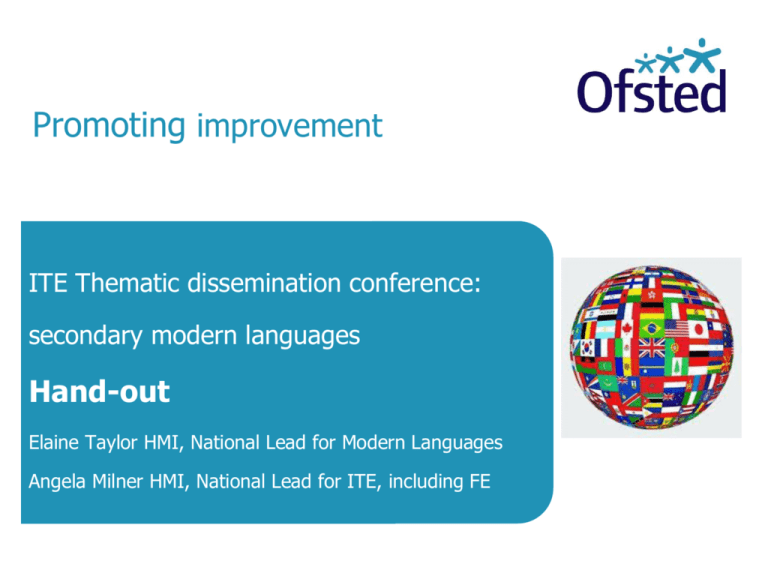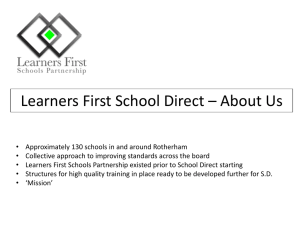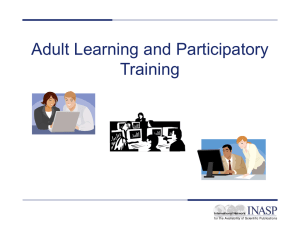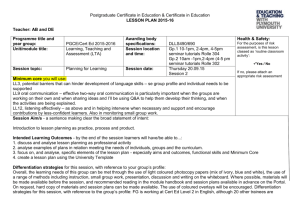Promoting improvement in Initial Teacher Education (ITE)
advertisement

Promoting improvement ITE Thematic dissemination conference: secondary modern languages Hand-out Elaine Taylor HMI, National Lead for Modern Languages Angela Milner HMI, National Lead for ITE, including FE Key questions Recruitment and selection How well does the provider ensure trainees have the linguistic ability to communicate effectively in the target language? How rigorous is the identification of individual needs and does it lead to training plans which address these, in particular the knowledge and understanding of the English education system by native speakers and the development of the trainees’ second teaching language? Training How effectively are trainees supported, especially by mentors in schools, to develop the key skills of appropriate target language use and the development of students’ speaking skills? Are trainees trained to develop their students’ intercultural understanding in all phases? Are trainees adequately prepared to meet the individual needs of all their students, especially where these are closely linked with language development − for example, the needs of bilingual students? How much emphasis is placed on developing trainees’ understanding of their role in cross-curricular aspects such as developing the students’ literacy levels and their use of information and communication technology? Does the experience of other phases allow adequate time for trainees to develop an accurate understanding of transition issues? Are they given practical support in how to prepare their students for transition to the sixth form? Coherence How strong is the coherence between the generic professional training and the subject-specific training on matters where aspects of subject pedagogy pose particular challenges − for example, the management of behaviour and the use of the target language to manage lessons? Key strengths of trainees The vast majority demonstrate passion for the subject. They have good subject knowledge, many being native speakers. Partnerships are providing good support for developing their understanding of the British education system. They develop pupils’ intercultural understanding well, especially if they have already worked as foreign language assistants. They manage behaviour well, understand the need for differentiation and engage learners well by using a wide range of activities, including group and pair work. They make very good use of technology to deliver lessons, to introduce authentic materials and to add interest. Less well developed is their ability to allow technology to be used by pupils. Features of training Good use by subject leaders of subject associations, Ofsted reports and research to keep the courses up to date on key issues. Good support for developing behaviour management strategies. Good training in planning, both short and medium term. Examples of good preparation to teach disabled pupils and those who have special educational needs. ‘Given a bag of tricks for use in the classroom’. Some good practice in developing trainees’ understanding of transition. Features of training − continued ‘Trainees link with primary trainees at another local provider which includes shadowing their primary partner and vice versa.’ The quality of subject knowledge auditing varies greatly. Outstanding examples were seen which included an audit of cultural awareness, but in many cases trainees’ skills in a second language were ignored. Areas for improvement Trainees are not developing a strong ability to use the target language in their lessons. Often this is because of policies in schools. As a result, trainees are not developing skills such as modelling. Mentors make too little reference to target language use in their feedback and the matter is rarely seen as an aspect to be developed. Understanding of transition matters is weak. Opportunities in the primary phase can be limited to a token visit with too little time to reflect on the experience. Sometimes no modern language lessons are seen during the visits. This aspect of the training was weak even in outstanding partnerships. The experience trainees have of sixth form and in some cases Key Stage 4 teaching is very variable. This limits trainees’ ability to understand how to stretch more able pupils lower down the school. Subject knowledge enhancement for trainees’ second language is often weak or missing. Trainees have variable experience of teaching pupils for whom English is an additional language and training does not provide them with an understanding of the implications for the subject. Primary headlines in school inspections Teaching is improving in primary schools where teachers are gaining confidence in the subject through good support from secondary schools or, in a very small proportion of schools, from local authority advisers. A significant proportion of schools are not meeting entitlement requirements. Teaching results in positive attitudes and good intercultural development but does not consistently develop linguistic competence. Progression in one language is not built into curriculum plans. Teachers generally use good primary pedagogy to positive effect. For the most part, they plan engaging lessons with a wide variety of stimulating activities. As a result, pupils show clear enjoyment of their language lessons. Most of the primary schools visited have no systems for assessing pupils’ progress. Secondary headlines At secondary level, internet developments support the use of authentic materials. Departments are broadening approaches to teaching and learning to include: − tried and trusted methods done well − imaginative topics − cross-curricular dimensions. Across all phases, good practice in the use of information and communication technology is helping to improve learners’ listening skills. Insufficient use of the target language by teachers across all phases leads to a lack of spontaneity on the part of learners and over-dependence on written prompts. Secondary headlines − continued In approximately 20% of the schools no account was taken of primary or middle school experiences. 89% of schools in the sample withdrew some pupils from language lessons Lessons are often insufficiently differentiated. The range of ability in most secondary classes, particularly in Key Stage 4, is wide and more able students are often insufficiently challenged. Cross-phase headlines Across all phases, good practice in the use of information and communication technology is helping to improve learners’ listening skills. Insufficient use of the target language by teachers across all phases leads to a lack of spontaneity on the part of learners and over-dependence on written prompts. Judging the use of the target language (TL) by teachers and students: for guidance only Inadequate Teachers use English where the TL could be used to an unnecessary or excessive extent. Teachers use some TL for praise and greetings and for the occasional instructions, but switch rapidly and frequently between the TL and English. Teachers provide insufficient opportunities for learners to use the TL for meaningful communication. Requires improvement Teachers use the TL for organisational matters and for praise. They resort to immediate English translations by themselves or learners which reduces the impact. Learners are given opportunities to participate in conversations in the TL, but expectations of the spontaneous use by learners are too low. As learners move through the school, teachers expect them to use an increasing amount of target language. There are inconsistencies in the quality and quantity of the use of the TL across the department. Good Teachers provide a consistently fluent and accurate model of the foreign language for learners to emulate. English is only used where appropriate. Students are encouraged to ask questions and seek clarification in the TL during teacher-led sections of the lesson. Learners occasionally respond to the teacher spontaneously in the TL, but do not seek to use it to communicate with each other. Learners are expected to use the TL with greater fluency as they move through the key stages. Teachers ensure that all learners experience the need to react to unpredictable elements in conversations. Teachers praise and encourage spontaneous use by learners when it occurs. There is a high level of consistency in the quality and quantity of TL use across the department, supported by a unified departmental policy. Outstanding practice The TL is the dominant means of communication in the lesson and teachers have high expectations of learners’ use at an appropriate level. As a result, learners seek to use the TL as the normal means of communication when talking to the teacher or informally to each other. Teachers informally monitor and assess spontaneous TL use, keeping track of learners’ progress in order to ensure that their expectations increase as they move through the school. Teachers’ target language use is monitored by subject leaders and good practice is regularly shared across the department, resulting in a high level of consistency. Web link and associated materials available on the Ofsted website www.ofsted.gov.uk/resources/our-expert-knowledge/modern-languages





